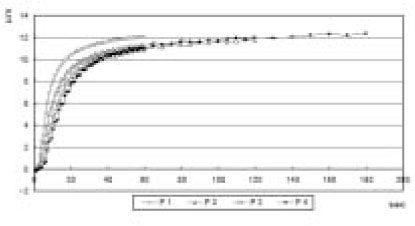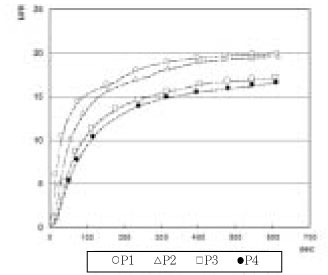Articles
- Page Path
- HOME > Restor Dent Endod > Volume 33(4); 2008 > Article
- Original Article Effect of intermittent polymerization on the rate of polymerization shrinkage and cuspal deflection in composite resin
- Min Kyung Kim, Sung Ho Park, Deog Gyu Seo, Yun Jung Song, Yoon Lee, Chan Young Lee
-
2008;33(4):-351.
DOI: https://doi.org/10.5395/JKACD.2008.33.4.341
Published online: July 31, 2008
Department of Conservative Dentistry, College of Dentistry, Yonsei University, Korea.
- Corresponding Author: Chan Young Lee. Department of Conservative Dentistry, College of Dentistry, Yonsei University, 134 Shinchon-Dong, Seodaemun-Ku, Seoul, 120-752, Korea. Tel: 82-2-2228-8700, Fax: 82-2-313-7575, chanyoungl@yuhs.ac
Copyright © 2008 The Korean Academy of Conservative Dentistry
- 700 Views
- 5 Download
Abstract
-
This study investigated the effect of intermittent polymerization on the rate of polymerization shrinkage and cuspal deflection in composite resins.The linear polymerization shrinkage of each composite was measured using the custom-made linometer along with the light shutter specially devised to block the light at the previously determined interval. Samples were divided into 4 groups by light curing method; Group 1) continuous light (60s with light on); Group 2) intermittent light (cycles of 3s with 2s light on & 1s with light off for 90s); Group 3) intermittent light (cycles of 2s with 1s light on & 1s with light off for 120s); Group 4) intermittent light (cycles of 3s with 1s light on & 2s with light off for 180s). The amount of linear polymerization shrinkage was measured and its maximum rate (Rmax) and peak time (PT) in the first 15 seconds were calculated. For the measurement of cuspal deflection of teeth, MOD cavities were prepared in 10 extracted maxillary premolars. Reduction in the intercuspal distance was measured by the custom-made cuspal deflection measuring machine. ANOVA analysis was used for the comparison of the light curing groups and t-test was used to determine significant difference between the composite resins.Pyramid showed the greater amount of polymerization shrinkage than Heliomolar (p < 0.05). There was no significant difference in the linear polymerization shrinkage among the groups. The Rmax was group 4 < 3, 2 < 1 in Heliomolar and group 3 < 4 < 2, 1 in Pyramid (p < 0.05). Pyramid demonstrated greater cuspal deflection than Heliomolar. The cuspal deflection in Heliomolar was group 4 < 3 < 2, 1 and group 4, 3 < 2, 1 in Pyramid (p < 0.05).It was concluded that the reduced rate of polymerization shrinkage by intermittent polymerization can help to decrease the cuspal deflection.
- 1. Alvarez-Gayosso C, Barcelo-Santana F, Guerrero-Ibarra J, Saes-Espinola G, Canseco-Martinez MA. Calculation of contraction rates due to shrinkage in light-cured composites. Dent Mater. 2004;20(3):228-235.ArticlePubMed
- 2. Bausch JR, de Lange K, Davidson CR, Peters A, de Gee AJ. Clinical significance of polymerization shrinkage of composite resins. J Prosthet Dent. 1982;48: 59-67.ArticlePubMed
- 3. Jorgensen KD, Asmussen E, Shimokobe H. Enamel damages caused by contracting restorative resins. Scand J Dent Res. 1975;83: 120-122.ArticlePubMed
- 4. Davidson CL, de Gee AJ. Relaxation of polymerization contraction stresses by flow in dental composites. J Dent Res. 1984;63: 146-148.ArticlePubMedPDF
- 5. Bouschlicher MR, Rueggeberg FA. Effect of ramped light intensity on polymerization force and conversion in a photoactivated composite. J Esthet Dent. 2000;12: 328-339.ArticlePubMed
- 6. Eick JD, Welch FH. Polymerization shrinkage of posterior composite resins and its possible influence on postoperative sensitivity. Quintessence Int. 1986;17: 103-111.PubMed
- 7. Kemp-Scholte CM, Davidson CL. Marginal sealing of curing contraction gaps in Class V composite resin restorations. J Dent Res. 1988;67(5):841-845.ArticlePubMedPDF
- 8. Lutz F, Krejci I, Barbakow F. Quality and durability of marginal adaptation in bonded composite restoration. Dent Mater. 1991;7: 197-213.PubMed
- 9. Kanca J, Suh BI. Pulse activation : Reducing resin-based composite contraction stresses at the enamel cavosurface margins. Am J Dent. 1999;12: 107-112.PubMed
- 10. Roberts JC, Powers JM, Craig RG. Fracture toughness of composite and unfilled restorative resins. J Dent Res. 1977;56: 748-753.ArticlePubMedPDF
- 11. Sakaguchi RL, Peter MC, Nelson SR, Douglas WH, Poort HW. Effects of polymerization contraction in composite restorations. J Dent. 1992;20(3):178-182.ArticlePubMed
- 12. Antonucci JM, Toth EE. Extent of polymerization of dental resins by differential scanning calorimetry. J Dent Res. 1983;62: 121-125.ArticlePubMedPDF
- 13. Venhoven BAM, de Gee AJ, Davidson CL. Light initiation of dental resins : dynamics of the polymerization. Biomaterials. 1996;17: 2313-2318.ArticlePubMed
- 14. Park SH, Lee SY, Cho YS, Kim SS. Amount of Polymerization Shrinkage and Shrinkage Stress in Composites and Compomers for Posterior Restoration. J Korean Acad Conserv Dent. 2003;28: 348-353.Article
- 15. de Gee AJ, Feilzer AJ, Davidson CL. The linear polymerization shrinkage of unfilled resins and composites determined with a linometer. Dent Mater. 1993;9: 11-14.PubMed
- 16. Feilzer AJ, Dooren LH, de Gee AJ, Davidson CL. Influence of light intensity on polymerization and integrity of restoration-cavity interface. Eur J Oral Sci. 1995;103: 322-326.PubMed
- 17. Unterbrink GL, Muessner R. Influence of light intensity on two restorative systems. J Dent. 1995;23: 183-189.ArticlePubMed
- 18. Uno S, Asmussen E. Marginal adaptation of a restorative resin polymerized at reduced rate. Scand J Dent Res. 1991;99: 440-444.ArticlePubMed
- 19. Mehl A, Hickel R, Kunzelmann KH. Physical properties and gap formation of light-cured composites with and without 'softstart-polymerization'. J Dent. 1997;25: 321-330.ArticlePubMed
- 20. Goracci G, Mori G, de Martinis LC. Curing light intensity and marginal leakage of resin composite restorations. Quintessence Int. 1996;27: 355-362.
- 21. Dennison JB, Yaman P, Seir R, Hamilton JC. Effect of variable light intensity on composite shrinkage. J Prosthet Dent. 2000;84: 499-505.ArticlePubMed
- 22. Rueggeberg FA, Craig RG. Correlation of parameters used to estimate monomer conversion in a light activated resin composite. J Dent Res. 1988;67: 932-937.ArticlePubMedPDF
- 23. Lee SY, Park SH. Measurements of Shrinkage Stress and Reduction of Inter-cuspal Distance in Maxillary Premolars Resulting from Polymerization of Composites and Compomers. J Korean Acad Conserv Dent. 2004;29: 346-352.Article
- 24. Suliman AA, Boyer DB, Lakes RS. Cusp movement in premolars resulting from composite polymerization shrinkage. Dent Mater. 1993;9: 6-10.PubMed
- 25. Ericson D, Paulsson L, Sowaik H, Derand T. Reduction of cusp deflection resulting from composite polymerization shrinkage, using a light-transmitting cone. Scand J Dent Res. 1994;102: 244-248.ArticlePubMed
- 26. Obici AC, Sinhoreti MA, de Goes MF, Consani S, Sobrinho LC. Effect of the photo-activation method on polymerization shrinkage of restorative composites. Oper Dent. 2002;27: 192-198.PubMed
- 27. Brackett WW, Haisch LDA, Covey DA. Effect of plasma arc curing on microleakage of Class V resin-based composite restorations. Am J Dent. 2000;13: 121-122.PubMed
- 28. Walls AWC, McCabe JF, Murray JJ. The polymerization contraction of visible-light activated composite resins. J Dent. 1988;16: 177-181.ArticlePubMed
- 29. Rueggeberg FA, Caughman WF, Curtis JW Jr. Effect of light intensity and exposure duration on cure of resin composite. Oper Dent. 1994;19: 26-32.PubMed
- 30. Rueggeberg F. Contemporary issues in photocuring. Compend Contin Educ Dent Suppl. 1999;(25):S4-S15.
- 31. Davidson-Kaban SS, Davidson CL, Feilzer AJ, de Gee AJ, Erdilek N. The effect of curing light variations on bulk curing and wall-to-wall quality of two types and various shades of resin composites. Dent Mater. 1997;13: 344-352.ArticlePubMed
- 32. Koran P, Kurschner R. Effect of sequential versus continuous irradiation of a light-cured resin composite on shrinkage, viscosity, adhesion and degree of polymerization. Am J Dent. 1998;11: 17-22.PubMed
- 33. Asmussen E, Peutzfeldt A. Flexural strength and modulus of a step-cured resin composite. Acta Odontol Scand. 2004;62: 87-90.ArticlePubMed
- 34. Asmussen E, Peutzfelt A. Influence of UEDMA, Bis-GMA and TEGDMA on selected mechanical properties of experimental composite resins. Dent Mater. 1998;14: 51-56.PubMed
- 35. Lambrechts P, Braem M, Vanherle G. In: Derrick DD, editor. Evaluation of clinical performance for posterior composite resins and dentine adhesives. The Dental Annual. 1988;London: Butterworth and Co. Ltd; 147-187.
- 36. Suh BI, Feng L, Wang Y, Cripe C, Cincione F, de Rijk W. The effect of the pulse-delay cure technique on residual strain in composites. Compendium. 1999;20: 4-12.
- 37. Asmussen E, Peutzfelt A. Influence of pulse-delay curing on softening of polymer structures. J Dent Res. 2001;80: 1570-1573.ArticlePubMedPDF
- 38. Sideridou I, Tserki V, Papanastasiou G. Study of water sorption, solubility, and modulus of elasticity of light-cured dimethacrylate-based dental resins. Biomaterials. 2003;24: 655-665.PubMed
- 39. Peutzfeldt A, Sahafi A, Asmussen E. Characterization of resin composites polymerized with plasma arc curing units. Dent Mater. 2000;16: 330-336.ArticlePubMed
- 40. Lim BS, Ferracane JL, Sakaguchi RL, Condon JR. Reduction of polymerization contraction stress for dental composites by two-step light-activation. Dent Mater. 2002;18: 436-444.PubMed
REFERENCES

There is no statistical difference in all groups of the same resin. *indicates significant difference in the amount of linear polymerization shrinkage between Heliomolar and Pyramid at 95% level of confidence. Figures in the parenthesis indicate standard deviations.

Means with the same letter are not significantly different at p < 0.05 level. *indicates different maximum rate of polymerization shrinkage (Rmax) between Heliomolar and Pyramid at 95% levels of confidence.

Tables & Figures
REFERENCES
Citations









Figure 1
Figure 2
Figure 3
Figure 4
Figure 5
Figure 6
Figure 7
Figure 8
Restorative materials used in this study
List of investigated curing methods with their curing cycles
Amount of linear polymerization shrinkage (µm)
There is no statistical difference in all groups of the same resin. *indicates significant difference in the amount of linear polymerization shrinkage between Heliomolar and Pyramid at 95% level of confidence. Figures in the parenthesis indicate standard deviations.
Peak time (PT) which showed the highest rate of polymerization and maximum rate of polymerization shrinkage (Rmax)
Means with the same letter are not significantly different at p < 0.05 level. *indicates different maximum rate of polymerization shrinkage (Rmax) between Heliomolar and Pyramid at 95% levels of confidence.
Mean value of cuspal deflection at 10 min (µm)
Means with the same letter are not significantly different at p < 0.05 level. *indicates different the mean value of cuspal deflection between Heliomolar and Pyramid at 95% levels of confidence.
There is no statistical difference in all groups of the same resin. *indicates significant difference in the amount of linear polymerization shrinkage between Heliomolar and Pyramid at 95% level of confidence. Figures in the parenthesis indicate standard deviations.
Means with the same letter are not significantly different at p < 0.05 level. *indicates different maximum rate of polymerization shrinkage (Rmax) between Heliomolar and Pyramid at 95% levels of confidence.
Means with the same letter are not significantly different at p < 0.05 level. *indicates different the mean value of cuspal deflection between Heliomolar and Pyramid at 95% levels of confidence.

 KACD
KACD










 ePub Link
ePub Link Cite
Cite

